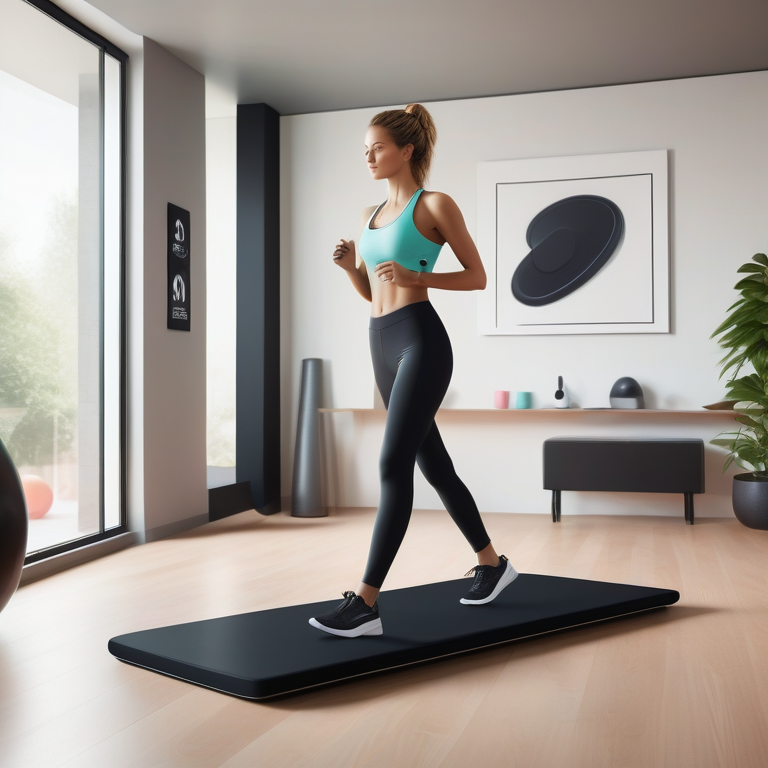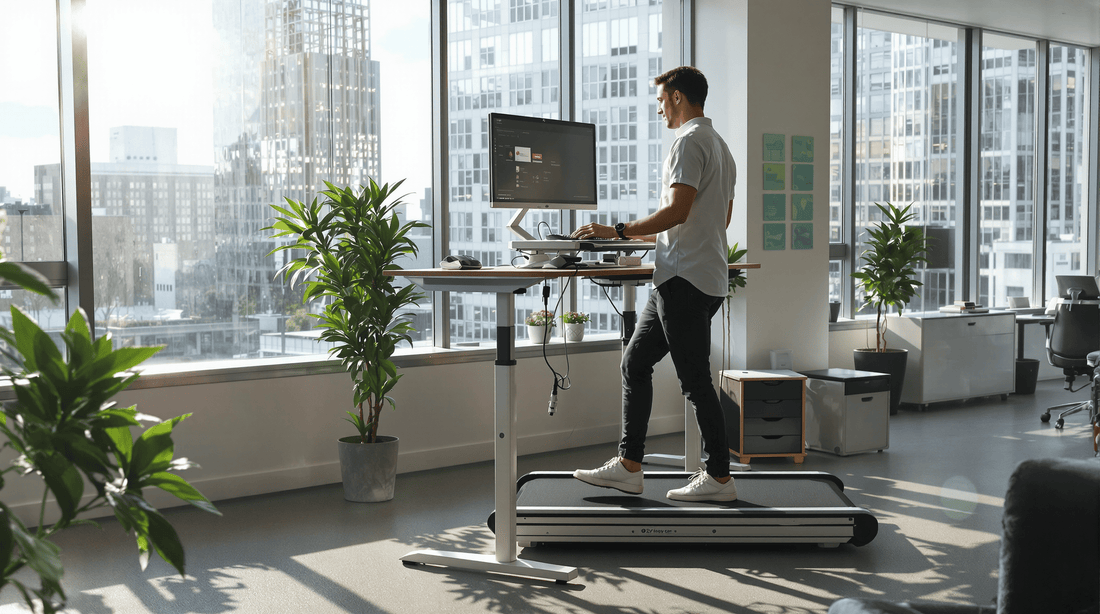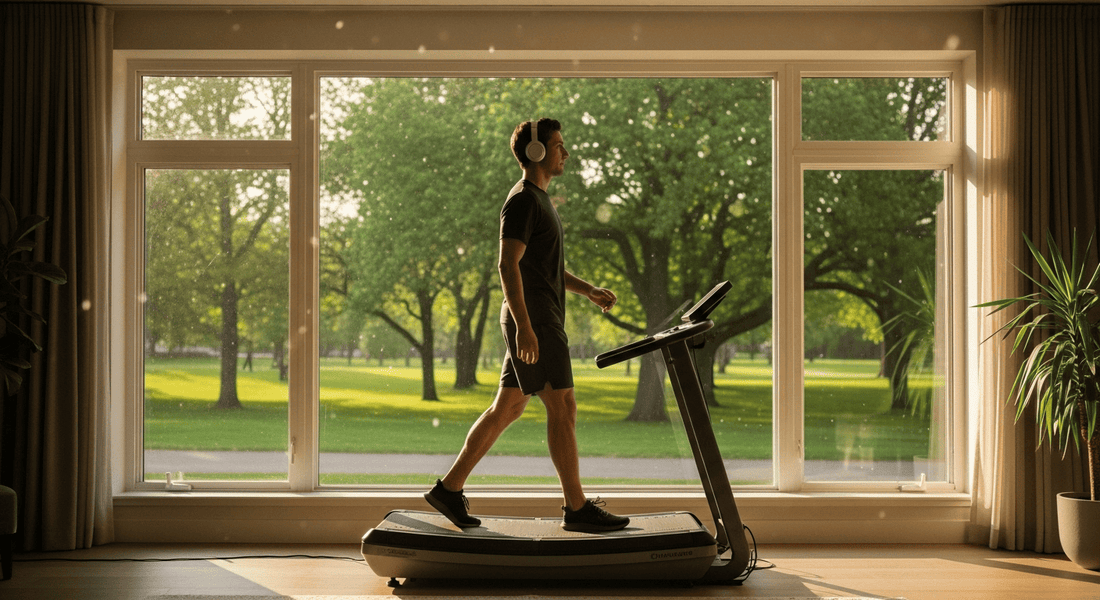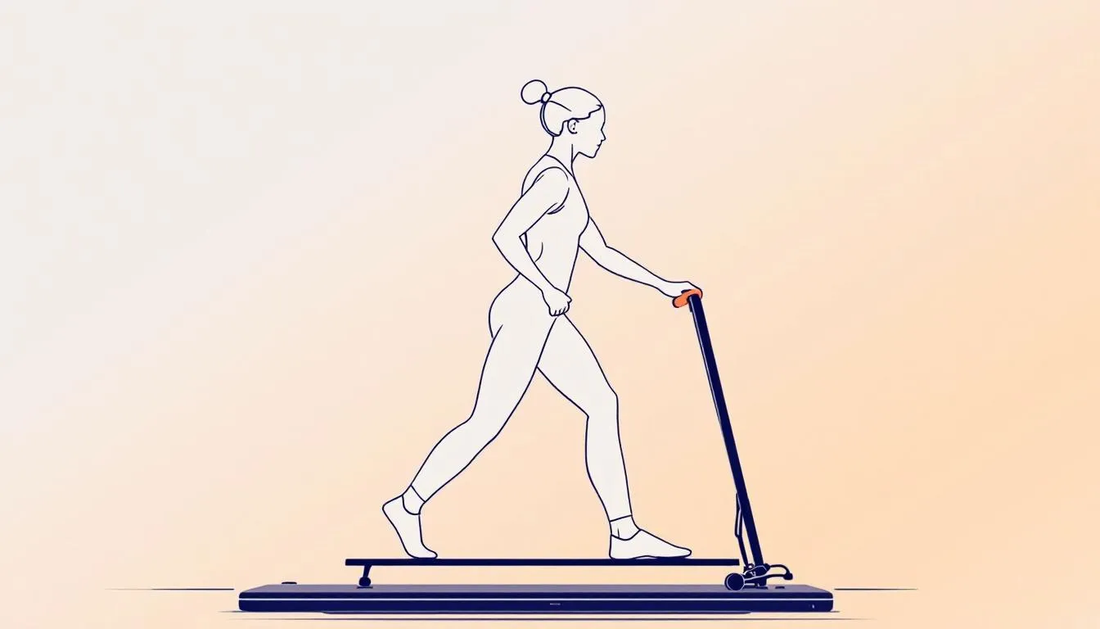Key Highlights
- Walking pad workouts provide a convenient and effective way to stay active, especially for those with busy schedules or limited space.
- From beginners to fitness enthusiasts, there's a walking pad workout for everyone, with options to adjust speed, incline, and duration.
- Walking pad exercises are low-impact, minimizing stress on joints while still offering cardiovascular benefits and muscle toning.
- Integrating walking pad routines into your daily life is easy—walk while working, watching TV, or even during video calls.
- Consistency is key! Start with achievable goals and gradually increase workout intensity and duration for sustainable progress.
Introduction
In today’s busy world, staying healthy can be tough. Balancing work, family, and friends often doesn’t leave much time for exercise. But ignoring your health can lead to problems later, like gaining weight and higher chances of health issues. A walking pad is a simple and practical way to add exercise into your day. You can work towards your weight loss goals and still keep up with a healthy diet.
Elevate Your Fitness Game with These Walking Pad Workouts
Walking pad workouts are a great way to get fit. They work for different fitness levels and goals. If you are a beginner starting your journey or a skilled athlete looking to stay fit, a walking pad can fit into your routine. These workouts help you improve your heart health, boost your energy, and feel better overall.
You can change the speed and incline settings to fit your level. This lets you personalize your walking to make it more challenging over time. The best part about walking pad workouts is how flexible they are. You can easily add them to your daily life. They don't take a lot of time or need special equipment.
1. The Beginner's 15-Minute Daily Walk
Starting a new workout routine can seem a bit hard, especially for beginners. The beginner's 15-minute daily walk is a great way to start. This gentle workout is good for getting used to exercise and making it a regular habit. Start by setting your walking pad to a slow pace. This way, you can easily talk while you walk.
As you get used to walking, you can slowly make the speed faster to raise your heart rate a bit. It is important to be regular in the beginning. Try to do this 15-minute walk every day and then increase the time as you get fitter.
The main goal is to build a lasting habit and enjoy walking, not to push yourself too hard. Soon, you will look forward to this daily exercise and notice how it helps your overall well-being.
2. Interval Training on the Walking Pad
Want to take your workout up a level? Trying interval training on the walking pad is a great way to challenge your heart. It can also boost your aerobic capacity and burn calories fast. The idea is easy: switch between fast walking and slow recovery periods.
Here’s a simple interval training routine to try:
- Warm-up: Spend 5 minutes walking at a gentle pace.
- Interval 1: Walk quickly for 1 minute.
- Recovery: Slow down to your comfortable pace for 1 minute.
- Interval 2: Walk uphill for 1 minute by increasing the incline.
- Recovery: Go back to your comfortable pace for 1 minute.
Do these intervals for 20-30 minutes. You can mix the intensity and time to fit your fitness level. Don't forget to cool down with a gentle 5-minute walk to lower your heart rate.
3. The Fat-Burning Power Walk
If you want to lose weight, try the fat-burning power walk. This workout helps you walk briskly, which raises your heart rate and helps you burn more calories. Start by setting your walking pad to a speed that is challenging but doable. You should be able to talk while walking, but it should take some effort.
Keep this brisk walking pace for at least 30 minutes. As you get stronger, try to walk for a longer time. You can make this walk more effective by adding hills. If your walking pad has an incline, increase it slowly to mimic walking uphill. This will work your leg muscles more and get your heart rate up.
Stay consistent to reach your weight loss goals. Aim to do this power walk 3-5 times a week along with a healthy diet for the best results. You will be surprised at how this easy walking routine can change your body and boost your metabolism.
4. Incline Challenges for Enhanced Stamina
Incline walking is a great way to build stamina and strength. It works your leg muscles and pushes your heart's limits. When you walk on an incline, you use different muscles than when walking on flat ground. This helps you burn more calories and tone your muscles better.
Start by setting your walking pad to a moderate incline. Find a pace that feels challenging but still lets you keep good form. As you get stronger, you can slowly increase the incline or shorten your breaks between intervals to boost your stamina even more.
Try to include incline sessions in your routine 2-3 times a week. Mix these with other walking pad exercises or take rest days. Always listen to your body and change the incline and pace if you need to. With hard work and consistency, you'll master those virtual hills and improve your stamina.
5. Walking Pad Meet Yoga: A Mind-Body Workout
Improve your balance and flexibility while you walk with this special workout. Start by walking slowly for a few minutes. This will warm up your muscles. Next, stop the walking pad and try some simple yoga poses.
The tree pose can help your legs get stronger and improve your balance. Standing forward folds are great for stretching your hamstrings and back.
Hold each pose for 30 seconds to a minute. Focus on your posture and breathe. If you have any balance issues, make sure to hold onto a wall or a chair for support. Regular practice helps you become more flexible, relaxes you, and can lower blood pressure.
Always listen to your body during yoga. Move at your pace and feel free to change poses or take breaks when needed. This mind-body workout will make you feel refreshed and more connected to your body.
6. The Cardio and Strength Combo
Are you looking for a workout that mixes cardio and strength training? Look no further. You can amp up your heart rate and build muscle with simple strength exercises during your walking pad routine. This mix helps make your bones stronger and can help fight heart disease while improving your metabolism.
Start with a 5-minute warm-up walk. After that, stop the walking pad. Next, alternate between strength exercises and quick bursts of brisk walking. Some good exercises include squats, lunges, push-ups, and tricep dips.
Do each strength exercise for 10 to 15 times. Then, follow it with a minute of brisk walking. This way, you keep your heart rate up while pushing your muscles. You can adjust the number of repetitions and walking time to match your fitness level. Don't forget to cool down with a gentle walk at the end of your workout.
7. Progressive Overload Walking Plan
Take your walking pad workouts further with a progressive overload plan. This way, you gradually make your workouts tougher by increasing the intensity, duration, or frequency of your walks. This helps you get better at being fit over time. Start by finding your baseline. This can be how far you can walk comfortably in 30 minutes or how many days a week you can walk.
From this starting point, try to increase the duration, speed, or incline of your walks just a little bit each week. For example, if you currently walk for 30 minutes, aim for 35 minutes next week. If you walk 1 mile in 30 minutes, try for 1.1 miles the week after.
The secret to progressive overload is making small changes that push your body, but not so much that you risk injury or overtraining. Pay attention to how your body feels and change your plan if needed. Keep in mind that consistency and slow progress are key to doing well with this method.
8. The Walking Pad Marathon Prep
Training for a marathon takes commitment and a clear plan. A walking pad may not let you cover the whole marathon distance, but it is a great way to improve your endurance and mental strength for running long distances. Start by slowly increasing how long you walk on the walking pad. Try to walk for at least one hour without a break.
Add intervals to your workouts. Change between brisk walking and resting at a slower pace. This helps you get used to the different speeds during a marathon. Make it more challenging by raising the incline on the treadmill to imitate uphill running.
Remember, a good marathon training plan includes outdoor running too. Use the walking pad to build your endurance and get your mind ready for the demands of marathon running.
Customizing Your Workout for Maximum Benefit
Walking pad workouts let you customize your exercise routine. You can change things like speed, incline, and duration to match your fitness level and goals. This helps you create a workout that is both challenging and doable. By personalizing your workout, you can avoid boredom and keep your progress going. It also helps you work on specific muscle groups.
You can choose shorter, high-intensity sessions or longer, endurance-focused ones. Your walking pad can fit your needs. It’s important to listen to your body and gradually increase intensity. Most importantly, make sure your workout is fun. When you enjoy your workout, you are more likely to stick with it.
Adjusting Speed for Your Fitness Level
One big benefit of a walking pad is that you can control your walking speed in miles per hour (mph). You can adjust the speed to fit your fitness level. This way, you can make your workout harder as you get better.
For beginners, start at a comfortable pace of about 2-3 mph. As you get fitter, slowly increase your speed by 0.5 mph at a time.
Keep in mind that it’s important to use the right form and not push yourself too hard. A good way to check if your speed is right is to see if you can talk easily while you walk. If you find it hard to breathe, slow down a little.
Incorporating Hand Weights
Want to increase the power and calorie burn of your walking pad workout? Adding light hand weights is an easy and effective way to make your routine better. Start with light weights, like 2-5 pounds, and slowly increase the weight as you get stronger.
Hold a weight in each hand. Move your arms naturally as you walk, keeping a slight bend in your elbows. The extra weight will work your upper body muscles, like your shoulders, biceps, and triceps. This helps you burn more calories and tone your muscles.
Always keep safety first when using weights during your workout. Pick a weight that is challenging but does not hurt your form. Avoid swinging the weights too much, as this can harm your joints.
Staying Motivated and Tracking Progress
Staying motivated and tracking your progress are very important parts of any good workout plan, including workouts on a walking pad. It helps to set clear goals, keep track of what you achieve, and reward yourself along the way. This can keep you engaged and excited about your fitness journey.
You can use a fitness tracker or app to check your steps, distance, and calories burned. This gives you a clear way to see how hard you are working. Watching your progress can inspire you to push harder and keep improving. Make sure to celebrate your milestones. This could be reaching a certain number of steps, walking for a set duration without a break, or just feeling more energetic and confident. These achievements are worth celebrating.
Setting Achievable Goals
Setting achievable goals is important for keeping your motivation high and staying committed to your walking pad workout plan. It’s best to set realistic targets that challenge you but do not stress you out. A great goal is specific, measurable, achievable, relevant, and time-bound.
Start by figuring out your starting fitness level. Set small goals that build on what you can already do. For example, if you are new to exercise, try to walk for 15 minutes each day in the first week. After that, you can add 5 more minutes each week.
Break bigger goals, like walking for an hour or a certain distance, into smaller, easier tasks. Celebrate these small wins along the way. Doing this will make you feel proud and keep you eager to do more. Remember, being consistent matters a lot. Even small steps can lead to big changes in your health and fitness over time.
Celebrating Milestones and Rewards
Celebrating milestones and rewarding yourself are important for staying motivated on your walking pad journey. When you meet your fitness goals, like walking for 30 minutes, reaching a certain number of steps, or simply feeling stronger and more energetic, take time to recognize these wins. Celebrating these achievements will boost your motivation and make your journey more enjoyable.
Rewards do not need to be big. You can enjoy a nice bath after a tough workout, treat yourself to a tasty but healthy meal, or watch an episode of your favorite TV show without guilt. These small rewards help you link your hard work with good results.
Also, when you acknowledge your successes, it helps build good habits and keeps you involved in your journey. So, appreciate your wins, no matter how little, and let them drive you forward on your fitness path.
Safety Tips for Walking Pad Workouts
Making sure you are safe during your walking pad workouts is very important. It helps to prevent injuries and helps you get the most from your exercise. Walking is an easy exercise, but if you do not use the right form or follow safety steps, you could get hurt.
Before you start on your walking pad, take some time to know how it works. Learn where the emergency stop button is and how to change the speed. Keep the area around you clear of things that could trip you. Have a water bottle next to you to stay hydrated during your workout. If you focus on safety, you will enjoy walking pad workouts more. This way, you can avoid problems from accidents that could have been prevented.
Proper Footwear for Injury Prevention
Wearing the right shoes is very important to prevent injuries during any exercise, including walking pad workouts. Good shoes provide support, cushioning, and stability. They lower the impact on your joints, stop blisters, and help you feel comfortable while working out.
Choose shoes made for walking or running. These shoes give you the right cushioning and support for repeated movement. Make sure your shoes fit well, giving your toes enough space and a tight fit around the heel. This prevents slipping. Stay away from shoes that are too loose or too tight, as both can cause discomfort and increase the chance of blisters.
Investing in good footwear is also an investment in your health and well-being. Shoes that don't fit well or aren't supportive can lead to foot pain, back pain, and serious injuries later on. Finding footwear that helps your feet and body will help you enjoy walking pad workouts without pain.
Maintaining Posture and Alignment
Maintaining the right posture and alignment is very important for making your walking pad workouts effective and keeping injuries, especially back pain, away. Good posture helps you use the right muscles, balances your body, and eases stress on your joints.
When you use the walking pad, stand straight. Keep your shoulders relaxed and your back upright. Try not to hunch or lean forward. This is important, as slouching can hurt your neck, shoulders, and back. Remember to use your core muscles to keep your body stable, and keep your chin parallel to the ground.
Take natural steps and avoid overstriding, which puts too much stress on your joints. If you feel any pain or discomfort, change your posture as needed. Keeping good posture not only makes your workouts better but also improves how your body moves and lowers the chance of long-term pain or other posture-related issues.
Beyond the Walk: Additional Exercises to Include
Walking pad workouts are a great way to stay active and get fit. Adding other exercises can make your routine even better. This helps you target different muscles and stop yourself from hitting a plateau. By including strength training, stretching, and balance exercises, you can create a complete fitness plan. This helps both your body and mind.
Think about adding bodyweight moves like squats, lunges, and push-ups. These can help you build muscle strength and endurance. Add some stretching or yoga to improve flexibility, movement, and posture. You can also try balance exercises to boost your stability and coordination. The main point is to pick activities you enjoy. This keeps your workouts engaging and makes them more useful along with your walking pad routine.
Pre-Walk Warm-Up Routines
Preparing your body for any workout is very important. This also applies to walking pad exercises. Before you start on your walking pad, a good warm-up routine can help. It can raise your heart rate, warm your muscles, and improve your flexibility. This makes your workout safer, more effective, and boosts your aerobic capacity.
Begin with light cardio exercises like arm circles, leg swings, and high knees. These movements help to increase blood flow to your muscles and get your joints ready for action. Next, do some dynamic stretches, such as torso twists, walking lunges with a twist, and hip circles. These moves will further improve your flexibility and range of motion while getting your heart rate up.
A good warm-up should take at least 5-10 minutes. You should feel slightly warm and loose, but not tired. By warming up properly, you prepare your body for what’s ahead. This can help lower your risk of injury and make your workout more productive.
Post-Walk Stretching for Recovery
After you finish your walking pad session, take a few minutes to stretch. This helps you recover and improve your flexibility. Focus on doing static stretches. Hold each stretch for 20 to 30 seconds. This allows your muscles to relax and stretch out.
Pay special attention to your major muscle groups, especially in your legs. Look at your calves, hamstrings, and quadriceps since these muscles work a lot while walking. You can do stretches like the standing calf stretch, seated forward fold, and lying quadriceps stretch. These will help ease muscle tightness and boost flexibility.
Stretching after you exercise can make recovery better. It helps lower muscle soreness and increases your range of motion. It also helps you relax. This important part of your fitness routine helps you feel calm and get ready for your next workout.
Conclusion
Walking Pad workouts are a great way to improve your fitness. They work for everyone, whether you are a beginner or more advanced. You can mix in interval training, strength exercises, and even yoga for full body health. Be sure to change the activity level to match your fitness. This will help you stay motivated. Always keep safety in mind by wearing the right shoes and maintaining good posture. These fun workouts can help you build stamina, lose fat, and feel better overall. Let’s get moving towards a healthier life with Walking Pad workouts!
Frequently Asked Questions
How long should beginners spend on a walking pad workout?
Beginners should try to exercise for 15 to 20 minutes. They should go at a slow and easy pace. This way, they can talk while moving and slightly raise their heart rate. The goal is to slowly add physical activity. It's important to build aerobic capacity without stressing the body.
Can walking pad workouts help with weight loss?
Yes, using a walking pad can help with weight loss. When you pair it with a healthy diet and a calorie deficit, it works even better. Brisk walking burns calories. Adding higher intensity intervals or using the incline feature can help you burn even more calories.
How often should I incorporate walking pad workouts into my routine?
The best number of walking pad workouts you should do depends on your fitness level and goals. A good target is to aim for 3 to 5 sessions every week. Each session should last at least 30 minutes. This gives you a nice mix of cardio and physical activity to see real improvements.
What are the signs of overdoing it with walking pad workouts?
Signs that you might be overtraining with walking pad workouts include feeling very tired, having muscle soreness that doesn't go away even if you rest, a higher resting heart rate, balance issues during or after your workouts, and a drop in your performance. It is important to focus on recovery. Listen to the signals your body sends. This will help you avoid injuries.





